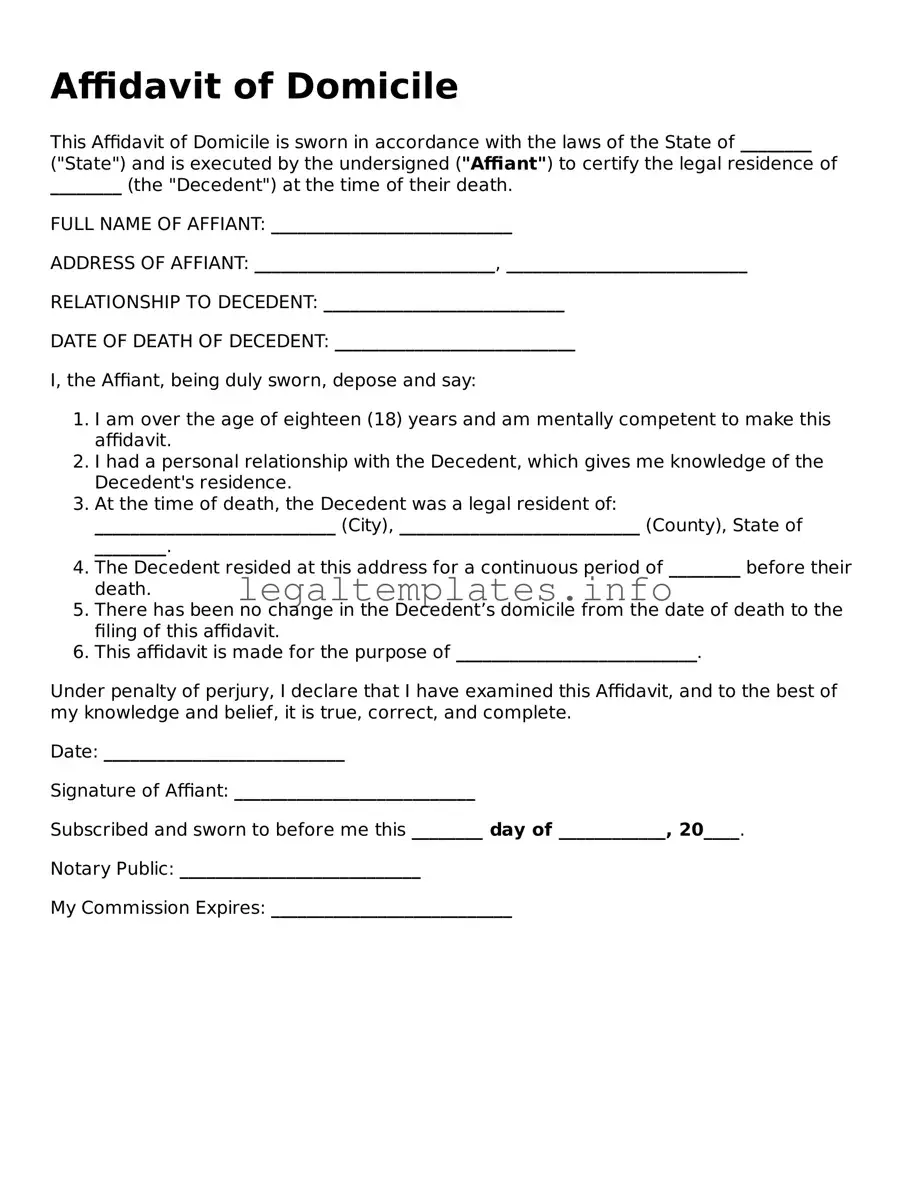An Affidavit of Domicile shares similarities with a Last Will and Testament in that both documents are essential in the estate planning and settlement process. The Affidavit of Domicile is used to verify the legal residence of a deceased person at the time of their death, which is critical for transferring assets to beneficiaries. Similarly, a Last Will and Testament outlines how a person's assets should be distributed after their death. Both serve as key documents in ensuring that the deceased's estate is properly managed and distributed according to their wishes or legal requirements.
A Declaration of Domicile is another document closely related to an Affidavit of Domicile, but it's used by living individuals. This declaration is a sworn statement where a person affirms their primary and permanent home. While an Affidavit of Domicile is used after someone passes away to establish where they lived for legal and estate purposes, a Declaration of Domicile is used by individuals to declare their current legal residence, often for tax purposes or to meet residency requirements in certain legal matters.
Similar to an Affidavit of Domicile, a Death Certificate is a critical document in estate settlement and legal affairs after someone dies. It officially certifies the date, location, and cause of death. This certification is necessary to access and distribute the deceased’s assets, just as the Affidavit of Domicile is required to prove their place of domicile at death. Both are indispensable in the legal process following someone’s passing, facilitating various procedural necessities.
An Affidavit of Heirship is somewhat akin to an Affidavit of Domicile as they both deal with the aftermath of a person's death, specifically regarding their estate. However, the Affidavit of Heirship is used to establish legally who the heirs or beneficiaries are when the deceased did not leave a Last Will and Testament. Like the Affidavit of Domicile, this affidavit helps in the proper distribution of the estate, ensuring that assets go to the rightful heirs according to state laws.
A Transfer on Death Deed (TODD) shares a purpose with an Affidavit of Domicile, albeit in a more proactive manner. While the Affidavit of Domicile is used posthumously to verify a decedent's legal residence, a TODD allows a property owner to name beneficiaries to inherit property upon their death, bypassing the probate process. Both documents are essential for smooth asset transfer but at different stages of estate planning and execution.
Power of Attorney (POA) documents are pivotal in managing one’s affairs, similar to the role of an Affidavit of Domicile after one’s death. While a POA designates an individual to make decisions on behalf of someone else in financial, medical, or other matters, an Affidavit of Domicile confirms the deceased’s residential jurisdiction. Each document thus serves to streamline the legal and financial processes at different life and death stages.
The Trust Declaration document bears resemblance to an Affidavit of Domicile since both play significant roles in estate management. A Trust Declaration outlines how assets placed in a trust should be handled and distributed, working during the individual's lifetime and after death. Meanwhile, an Affidavit of Domicile aids in the legal processes following death by certifying the decedent’s primary residence. Both are instrumental in ensuring assets are managed and transferred according to the deceased's wishes or legal standards.
Probate Court Documents, which encompass a variety of forms and filings within a probate case, are also closely related to the function of an Affididavit of Domicile. During the probate process, which involves proving a last will, settling an estate, and distributing the decedent’s assets, the Affidavit of Domicile serves to certify the deceased’s last place of residence, thus affecting tax implications and legal jurisdiction. These documents collectively ensure that the estate is administered correctly according to the local laws and the individual's circumstances.
Finally, an Estate Tax Return shares a common ground with an Affidavit of Domicile as both are integral to the estate settlement process. The Estate Tax Return is a form filed with the IRS to report the gross estate of the deceased and determine the estate tax due. The location of the decedent’s domicile, as certified by the Affidavit of Domicile, can significantly affect the calculation and liability for estate taxes. Both documents are crucial for a smooth and compliant transition of the estate.
